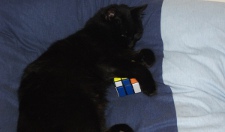Twisting Puzzles
Speed Solving
The Cube
Once you can comfortably solve a cube using a method that you have memorised, it is natural to want to do so more quickly. The cube that you use is a serious limiting factor. If you can't turn the cube faces with a push of your finger or it locks up as you turn, then you will either need to adjust your cube or consider a replacement.
To adjust a cube, you will need to take it apart. The first stage is to pop out the cubies. The caps on the centre pieces can usually be removed with a sharp knife (be really careful). They tend to be glued on during manufacture. When you remove the centre caps, you can see the screw that connects the centre piece to the core of the cube.
At this point, I put the all of the cubes back on, doesn't matter which order, you'll remove them again. I tighten the thing as much as it goes. I then do tiny little turns on all 6 screws (use the centre caps you removed to remind you of which ones you have turned) and test the cube after each adjustment. You want to be able to turn the cube more easily but don't want the pieces to fly out all over the place. The difference between stiff and loose depends on the types of thread in the screws. On a Rubik's brand, the thread is weird and the turn you are talking about is a tiny amount - less than 180°. On screws with denser threads, you will need to rotate the screw a turn or half a turn at a time.
When the cube is right, I take out all of the pieces and spray them with a silicone-based lubricant (must be petroleum free). You can sand down the edges that touch other cubies (removing 1 or 2 mm) as well if you want. When you spray them, wipe off the excess liquid and leave to dry.
The centre caps will stick a bit better if you give them a bit of a sanding before sticking them back on. Use superglue applied with a bent paperclip - you need a tiny amount. Don't stick yourself to the cube - it would be embarassing in A & E.
Put the whole thing back together, maybe replace the stickers too. Turn it lots to work in the lube and be proud of your DIY self.
The Timing Equipment
You don't need special timing equipment to see how long it takes you to do the cube. You can use timers on the computer or any old thing to get a sense of how quick you are.
Stackmat timers that were made for the cup stacking tournaments are also used for speed cubing. They are nice and you don't lose much time starting and stopping the timer. The one you buy from Speedstacks has a data port and can be connected to large and small displays if you really want. It costs a bit more than the one you get from the cube sellers though.
The Approach
When you first think about timing yourself, it might take you between 1 and 3 minutes. However long it takes you, there are essentially 3 factors beyond the cube that you are using that will make a significant difference to the time that it takes.
Reduce The Number Of Moves
When you use only a few algorithms to complete a stage, the chances are you have to do them more than once each time you solve the cube. For example, you can orient the bottom corners using 2 algorithms (which you have to do at least once each, maybe twice) or you can use 1 algorithm to do it in one go. You need to learn 7 algorithms and learn how to spot which one to use when you solve.
Whichever method you use, work on one stage at a time. If there are lots of algorithms to learn for the stage, work on 2 or 3 at a time. The pocket cube is a good way to practise corner algorithms.
If you halve the number of turns it takes you to solve the cube, you would seriously reduce the time it takes.
Spot Patterns Quickly
You lose time when you are looking at the cube to decide what to do. You need to be looking ahead all of the time and thinking about the next stage. The more you watch the cube as you turn, the more you get used to where pieces move during the solve.
You also lose time when you have to turn the cube. If you learn how to complete the early stages upside down, you never need to turn the cube over.
Turn More Quickly
Watch what they really quick people do. There are lots of videos on the WWW that show people doing finger tricks. The more you work these things into the algorithms that you use, the quicker you get.

